Degollado
Hacienda de Huáscato
This was owned by Ignacio E. Castellanos.
These cartones were modelo 5290, ordered from Juan Kaiser on 8 October 1915 at a cost of $30.
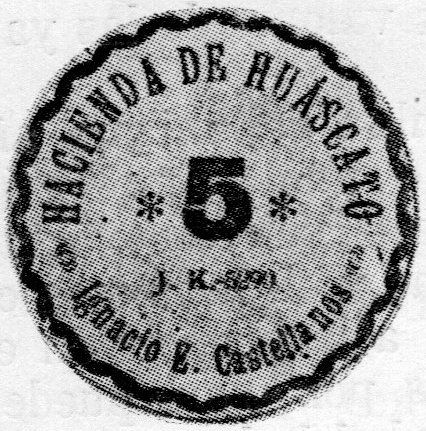
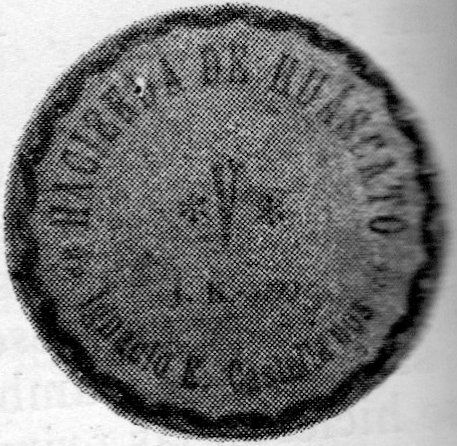 M2421 5c Hacienda de Huáscato
M2421 5c Hacienda de Huáscato
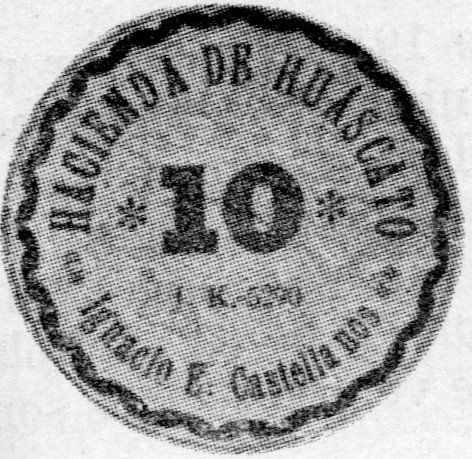
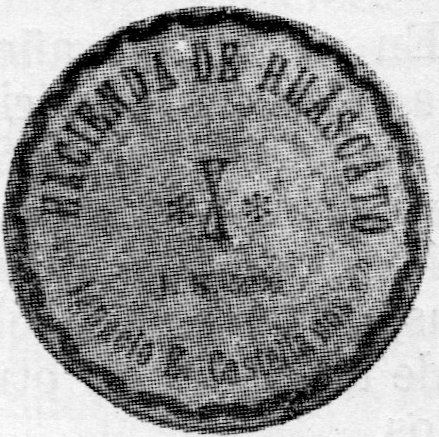 M2422 10c Hacienda de Huáscato
M2422 10c Hacienda de Huáscato
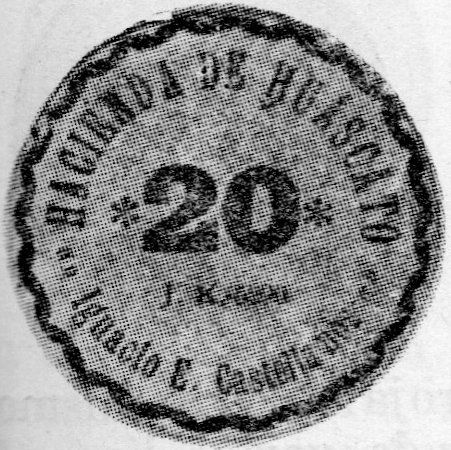
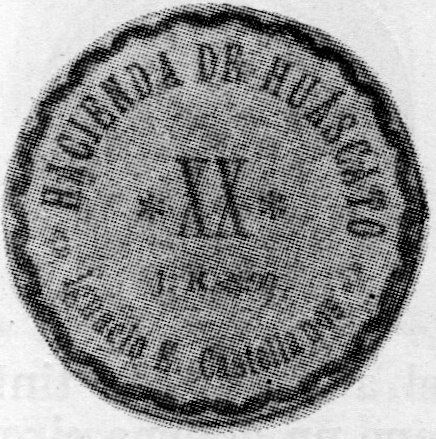 M2423 20c Hacienda de Huáscato
M2423 20c Hacienda de Huáscato
| total number |
total value |
||
| 5c | 700 | $ 35.00 | blue on round cream cartón |
| 10c | 700 | 70.00 | |
| 20c | 400 | 80.00 | |
| 50c | 200 | 100.00 | |
| 2,000 | $285.00 |
Hacienda El Zapote
Mariano Morales of Degollado was a leading Maderista in 1911El Regional, 3 June 1911.
He issued notes for 5c and 25c.
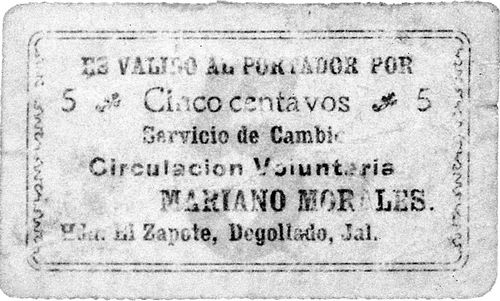 M2456 5c Hacienda El Zapote
M2456 5c Hacienda El Zapote
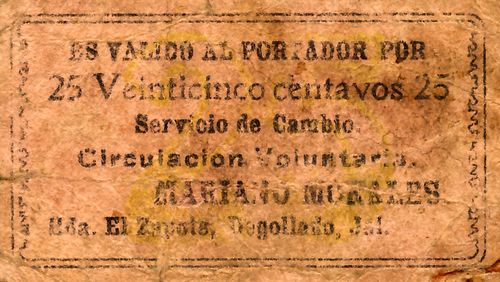 M2457 25c Hacienda El Zapote
M2457 25c Hacienda El Zapote
| date on note | from | to | total number |
total value |
||
| 5c | includes number 389 | |||||
| 25c |
This issue is similar to that of the Compañía de Fletes y García in Juchitlán, so will have dated from mid 1916.
Ejutla
Hacienda de La Cidra
In 1903 this hacienda was the largest in Ejutla. It was owned by Genaro Cañedo and administrated by Sixto Pulido, with 40 inhabitantsAHME, Minutarios del Ayuntamiento, 1903, 26 September 1903,f. s/n
A handwritten vale al portador for four pesos, dated 3 July 1916, from Juan Guzmán.
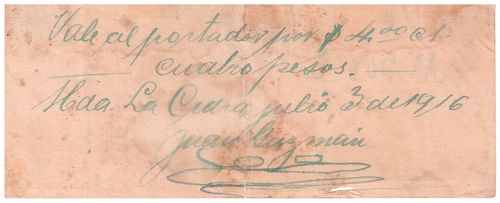 M2570 $4 Hacienda de la Cidra
M2570 $4 Hacienda de la Cidra
| date on note | from | to | total number |
total value |
||
| $4 | includes number 508 (C) |
| Juan Guzmán |  |
Etzatlán
Hacienda de San Sebastian
The original 17th century builder of this hacienda is unknown, but the Pacheco family, headed by Manuel Pacheco Calderón from Santander, Spain, became the owners in the mid-18th century.
In 1865 Manuel Fernández del Valle and his brother Justo arrived in the area from Asturias, Spain. They were determined to make their fortune in Mexico and they succeeded beyond their wildest dreams. They married two of the daughters of Francisco Martínez Negrete, an important Mexican businessman, and these marriages allowed access to the funds they needed to start their empire. The del Valle brothers bought textile factories, invested in railroads, bought mines, and started the Banco de Jalisco. By 1914, they had acquired the hacienda de San Sebastian at a price of $350,000. At the time, the hacienda possessed almost 65,000 acres and its primary focus was livestock, including cattle, horses, pigs, and sheep but it was still producing quantities of maiz, beans such as guasano and frijol, barley, wheat, and potatoes. Early records also show that the hacienda was well known for distilling and selling tequila as far back as the 17th century.
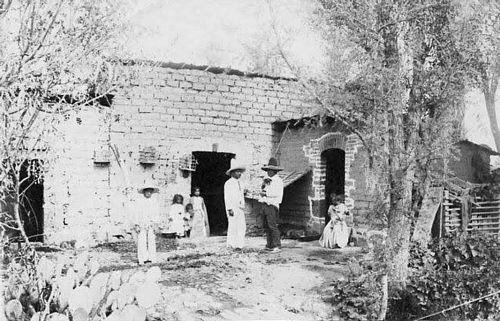
a peon with his family in front of his cottage
According to Carlos E. Parra Ron, Etzatlán's historian (cronista), "the hacendados’ vanity made them believe they were demi-gods...they were little interested in the misery they created, and those who suffered the consequences were the poor people." There was a vast gap in wealth and social standing between the hacendado and his family and the peones who worked for them. Patios with flower gardens and artistic sculptures might be enjoyed by the owner, but the workers lived in squalid, one-room, dirt-floored huts. San Sebastian's records show that 400 peones worked there in 1903. For them, a day's work paid only 37 centavos from which they had to support not only themselves but their families. Most were not lucky enough to be peones acasillados with free huts, so they might well have to pay rent to the hacendado for the privilege of living in their hovels. Such was the structure which underlay the hacienda owner's sumptuous life.
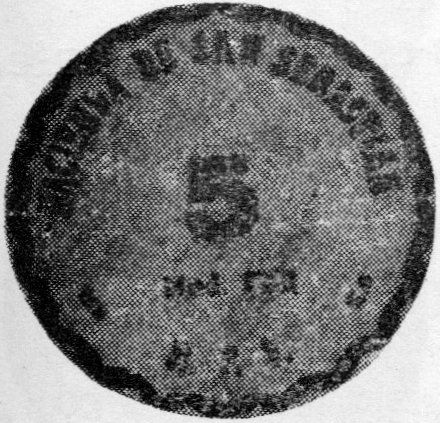
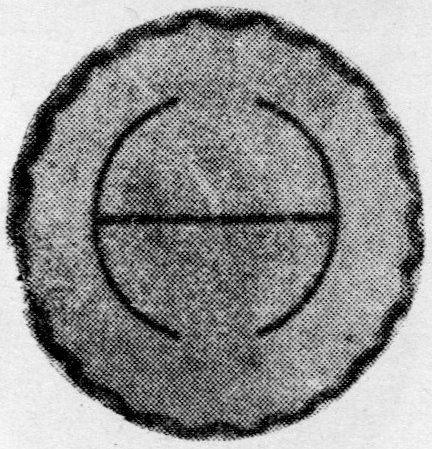 M2626 5c Hacienda de San Sebastian
M2626 5c Hacienda de San Sebastian
These were modelo 5225, maroon cartones produced by Juan Kaiser on 7 April 1915.
| Value | total number |
total value |
|
| 5c | 600 | $ 30.00 | round maroon cartón |
| 10c | 500 | 50.00 | |
| 20c | 500 | 100.00 | |
| 50c | 400 | 200.00 | |
| 2,000 | $380.00 |
A second order, on 22 June 1915, was for brown cartones in weirder denominations.
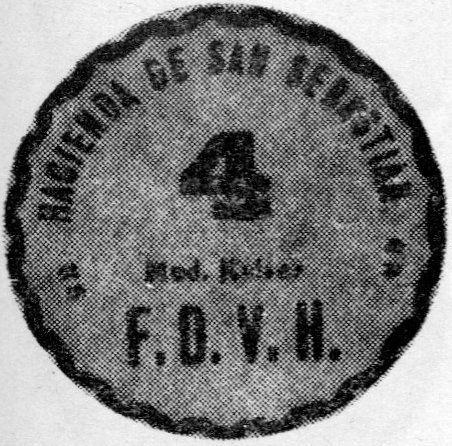
 M2631 4c Hacienda de San Sebastian
M2631 4c Hacienda de San Sebastian
| Value | total number |
total value |
|
| 4c | 200 | $ 8.00 | round brown cartón |
| 8c | 200 | 16.00 | |
| 12c | 200 | 24.00 | |
| 16c | 200 | 32.00 | |
| 20c | 200 | 40.00 | |
| 24c | 200 | 48.00 | |
| 28c | 200 | 56.00 | |
| 1,400 | $222.00 |
Señoritas Tomasa Romero y Hermana
Currently listed as a private issue but probably a hacienda issue.
Ixtlahuacán de los Membrillos
Hacienda de Buenavista
The hacienda of Buenavista had 2,900 hectares dedicated to the cultivation of wheat, corn, beans, chickpeas, mezcal and cattlePercy G. Holms. The directory of agencies, mines & haciendas 1905-1906, Mexico City, American Book & Printing Co., 1907. Despite this, between 1876 and 1914 the owner,Manuel Capetillo, was among the most indebted landowners, with three mortgages with the same number of creditors, for an amount of 68,000 pesos, which compromised his two haciendas (Buenavista and Las Aguilillas).
The newspaper El Informador gave Manuel Capetillo’s Buenavista as a model hacienda, which had a church, orchard, school (of which some towns would be jealous), stables, granaries, music band, etc. The labourers’ houses were spacious, had adobe walls and tile roofs, and small corrals. Most of its inhabitants had been born on the hacienda. At Christmas, since time immemorial, the landowner distributed clothes and sweets to children. Capetillo had always lived on the hacienda and paid his workers good wagesEl Informador, .
Manuel Capetillo had a friendship with Amado Aguirre, an ally of the Villistas led by Julián Medina, and thanks to the fact that he offered lunches and dinners to various revolutionary leaders, as well as pastures for his horses, enjoyed his favor and avoided looting and confrontation.
But everything changed a short time later, In September 1922 El Cruzado complained that after Capetillo's death, the administrator began to 'moniar', a word with which the peons denote the extortion of the workers, and drove several of them out of their homes.
The first order, modelo 4623, produced by Juan Kaiser on 21 January 1914, was for oblong cartones.
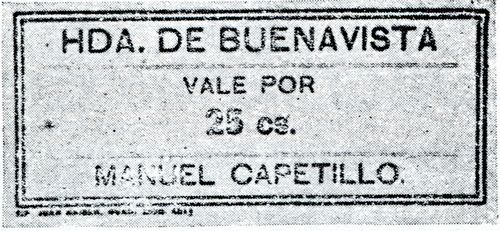 M2542 25c Hacienda de Buenavista
M2542 25c Hacienda de Buenavista
| total number |
total number |
||
| 20c | 500 | $100.00 | oblong orange cartón |
| 25c | 400 | 100.00 | oblong green cartón |
| 50c | 200 | 100.00 | oblong pink cartón |
| 100c | 200 | 200.00 | oblong blue cartón |
| 1,300 | $500.00 |
Another order, modelo 5135, on 26 June 1916, was for round cartones.
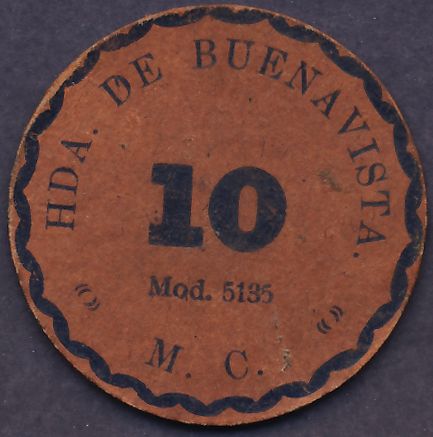
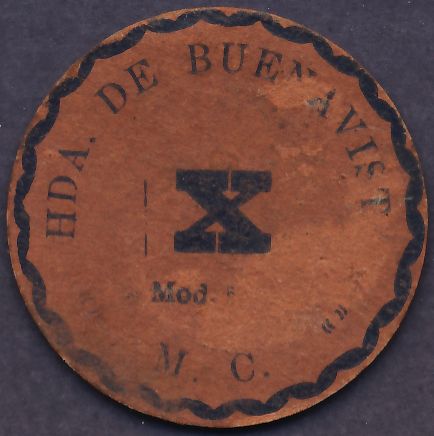 M2535 10c Hacienda de Buenavista
M2535 10c Hacienda de Buenavista
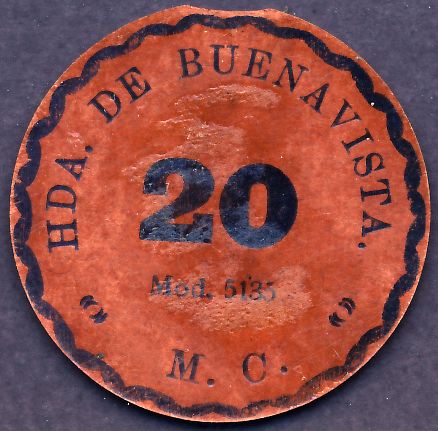
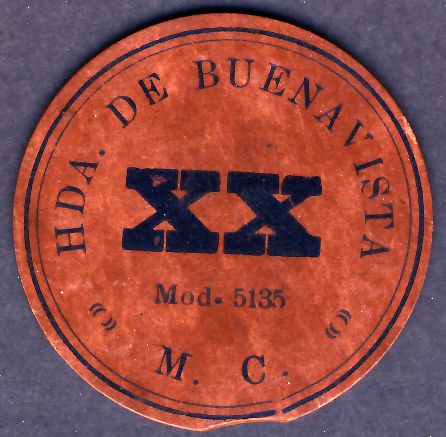 M2536 20c Hacienda de Buenavista
M2536 20c Hacienda de Buenavista
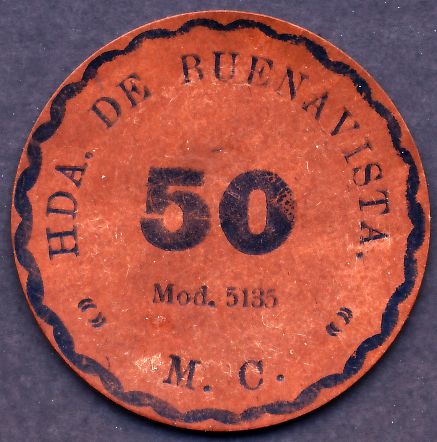
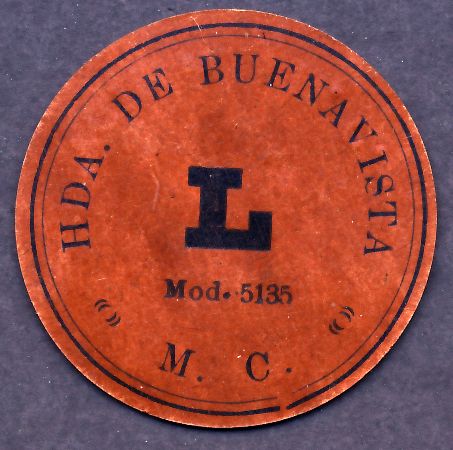 M2538 50c Hacienda de Buenavista
M2538 50c Hacienda de Buenavista
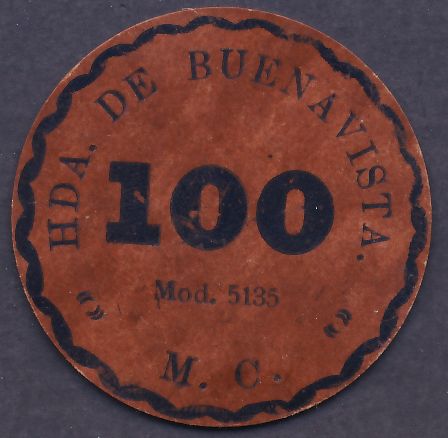
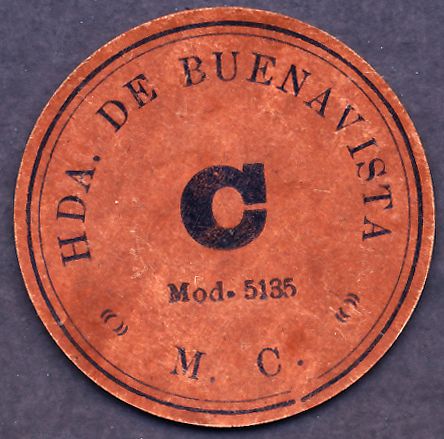 M2539 $1 Hacienda de Buenavista
M2539 $1 Hacienda de Buenavista
| total number |
total number |
||
| 10c | round cartón | ||
| 20c | 5,000 | $1,000.00 | |
| 50c | 2,000 | 1,000.00 | |
| 100c | 3,000 | 3,000.00 | |
| 10,000 | $5,000.00 |
Delgado does not list the 10c value.
Hacienda de Cedros
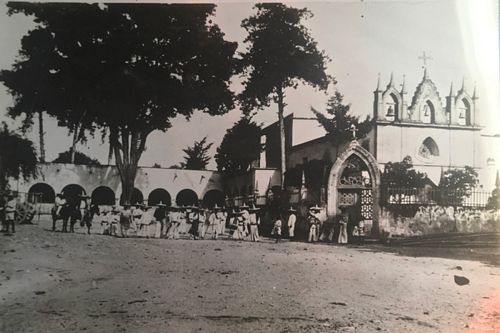
This hacienda had been in the Villaseñor family for over 200 years. On the eve of the revolution it was in the hands of Lorenzo S. Villaseñor. It produced corn, beans, and chickpeas as well as raising livestockSergio Manuel Valerio Ulloa, Capitalismo y oligarquía en Jalisco 1876-1919, El Colegio de México, 1999 (Tesis de doctorado en Historia)., p. 830{/footmote}.
These cartones were modelo 5193, produced by Juan Kaiser on 24 May 1915. They have the name of Lorenzo Villaseñor y Cia.
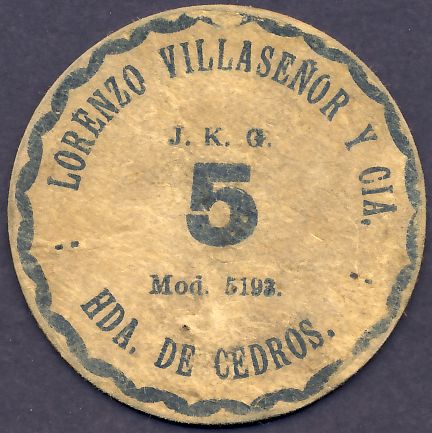
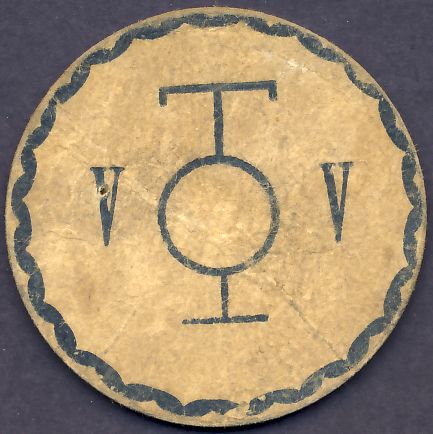 M2426 5c Hacienda de Cedros
M2426 5c Hacienda de Cedros
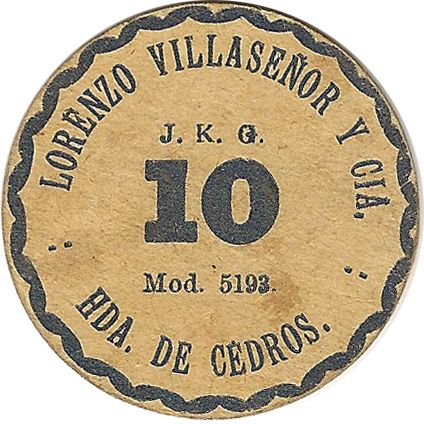 M2427 10c Hacienda de Cedros
M2427 10c Hacienda de Cedros
| total number |
total value |
Comment | |
| 1c | 375 | $ 3.75 | round manilla cartón |
| 5c | 375 | 18.75 | |
| 10c | 375 | 37.50 | |
| 20c | 375 | 75.00 | |
| 50c | 250 | 125.00 | |
| 100c | 250 | 250.00 | |
| 2,000 | $510.00 |
